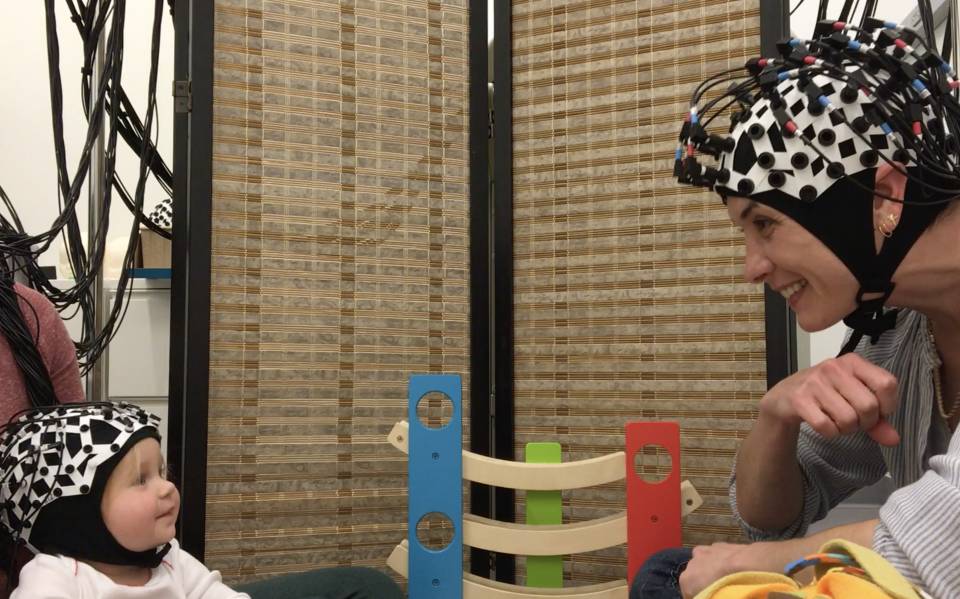Princeton research shows the power of connection in infant/caregiver interactions

New research from Princeton University has shown that when caregivers and infants interact, they are quite literally “on the same wavelength”, experiencing similar brain activity in the same brain regions.
In the first study of how infant and adult brains interact during natural play, researchers found “measurable similarities” in their neural activity. In other words, baby and adult brain activity rose and fell together as they shared toys and eye contact.
Associate research scholar Elise Piazza said that while previous research has shown that adults’ brains sync up when they watch movies and listen to stories, little is known about how this ‘neural synchrony’ develops in the first years of life.
The researchers began their work from a belief that neural synchrony has important implications for social development and language learning. Studying real life, face-to-face communication between infants and adults, however, proved challenging. Researchers needed to create a child-friendly method of recording brain activity simultaneously from baby and adult brains.
With funding from the Eric and Wendy Schmidt Transformative Technology Grant, the researchers developed a new dual-brain neuroimaging system that uses functional near-infrared spectroscopy (fNIRS), which is highly safe and records oxygenation in the blood as a proxy for neural activity. The setup allowed the researchers to record the neural coordination between babies and an adult while they played with toys, sang songs and read a book.
Using the same adult to interact with all 42 infants and toddlers in the study, researchers ended up with a final pool of 18 infants and toddlers, with 21 excluded for “excessive squirming” and a further three who refused to wear the cap.
The experiment had two portions. In one, the adult experimenter spent five minutes interacting directly with a child — playing with toys, singing nursery rhymes or reading Goodnight Moon — while the child sat on their parent’s lap. In the other, the experimenter turned to the side and told a story to another adult while the child played quietly with their parent.
The caps collected data from 57 channels of the brain known to be involved in prediction, language processing and understanding other people’s perspectives.
When the data was examined, researchers found that during the face-to-face sessions, the babies’ brains were synchronized with the adult’s brain in several areas known to be involved in high-level understanding of the world — perhaps helping the children decode the overall meaning of a story or analyze the motives of the adult reading to them.
When the adult and infant were turned away from each other and engaging with other people, the coupling between them disappeared.
While much of the data confirmed the researchers expectations, there were some surprises. For example, researchers found that the infant brain was often ‘leading’ the adult brain by a few seconds, suggesting that babies do not just passively receive input but may guide adults toward the next thing they’re going to focus on.
“While communicating, the adult and child seem to form a feedback loop,” Ms Piazza added. “That is, the adult’s brain seemed to predict when the infants would smile, the infants’ brains anticipated when the adult would use more ‘baby talk,’ and both brains tracked joint eye contact and joint attention to toys. So, when a baby and an adult play together, their brains influence each other in dynamic ways.”
This two-brain approach to neuroscience could open doors to understanding how coupling with caregivers breaks down in atypical development — such as in children diagnosed with autism — as well as how educators can optimize their teaching approaches to accommodate children’s diverse brains.
The researchers are continuing to investigate how this neural coupling relates to preschoolers’ early language learning. The study, Infant and adult brains are coupled to the dynamics of natural communication may be accessed here.
Popular

Policy
Practice
Provider
Quality
Research
Workforce
Beyond the headlines: celebrating educators and the power of positive relationships in early learning
2025-07-07 10:00:24
by Fiona Alston

Workforce
Policy
Quality
Practice
Provider
Research
ECEC must change now, our children can’t wait for another inquiry
2025-07-02 07:47:14
by Fiona Alston

Workforce
Quality
Practice
Provider
Research
Beyond the finish line: Championing child protection one marathon at a time
2025-07-08 09:15:32
by Fiona Alston













